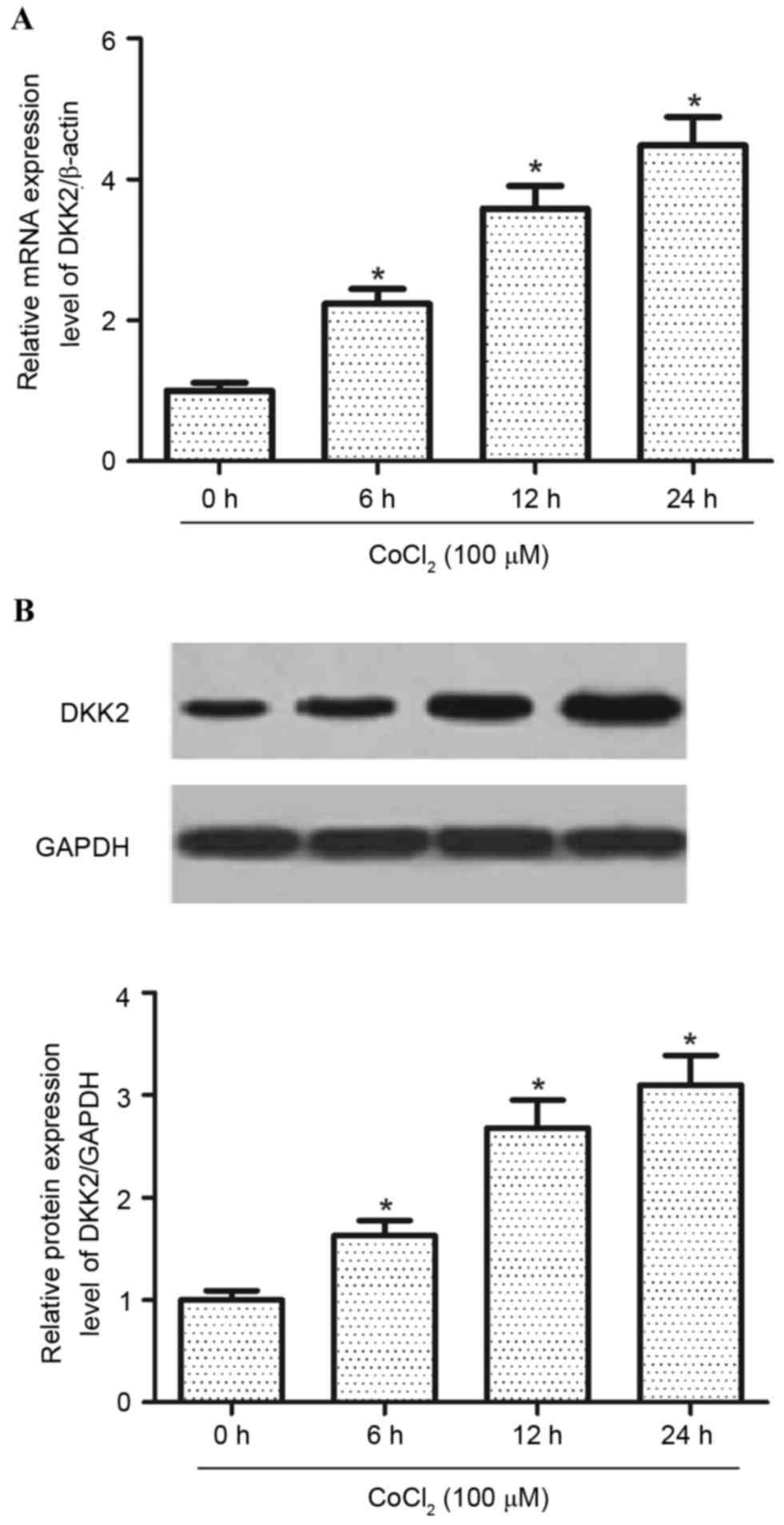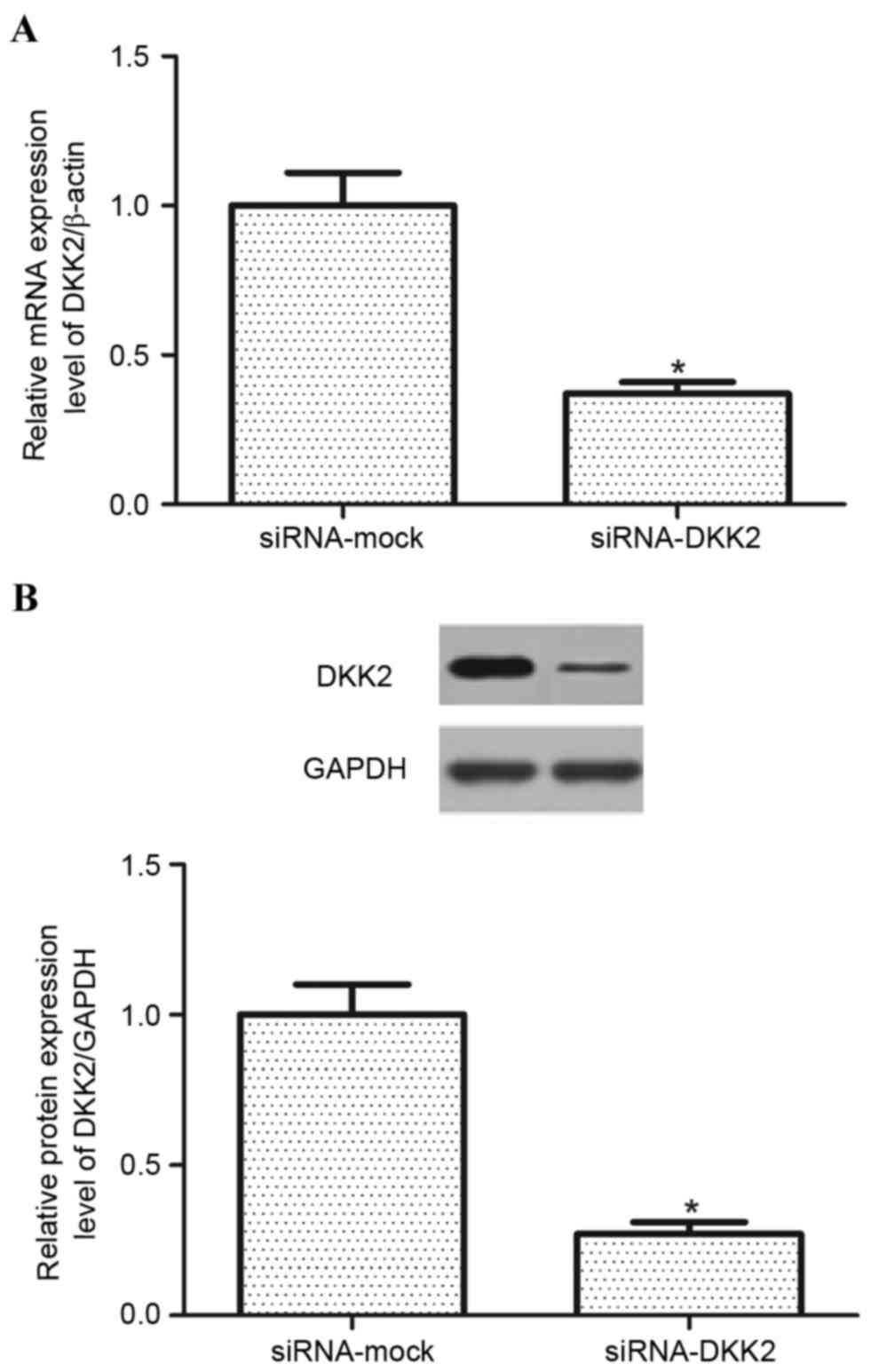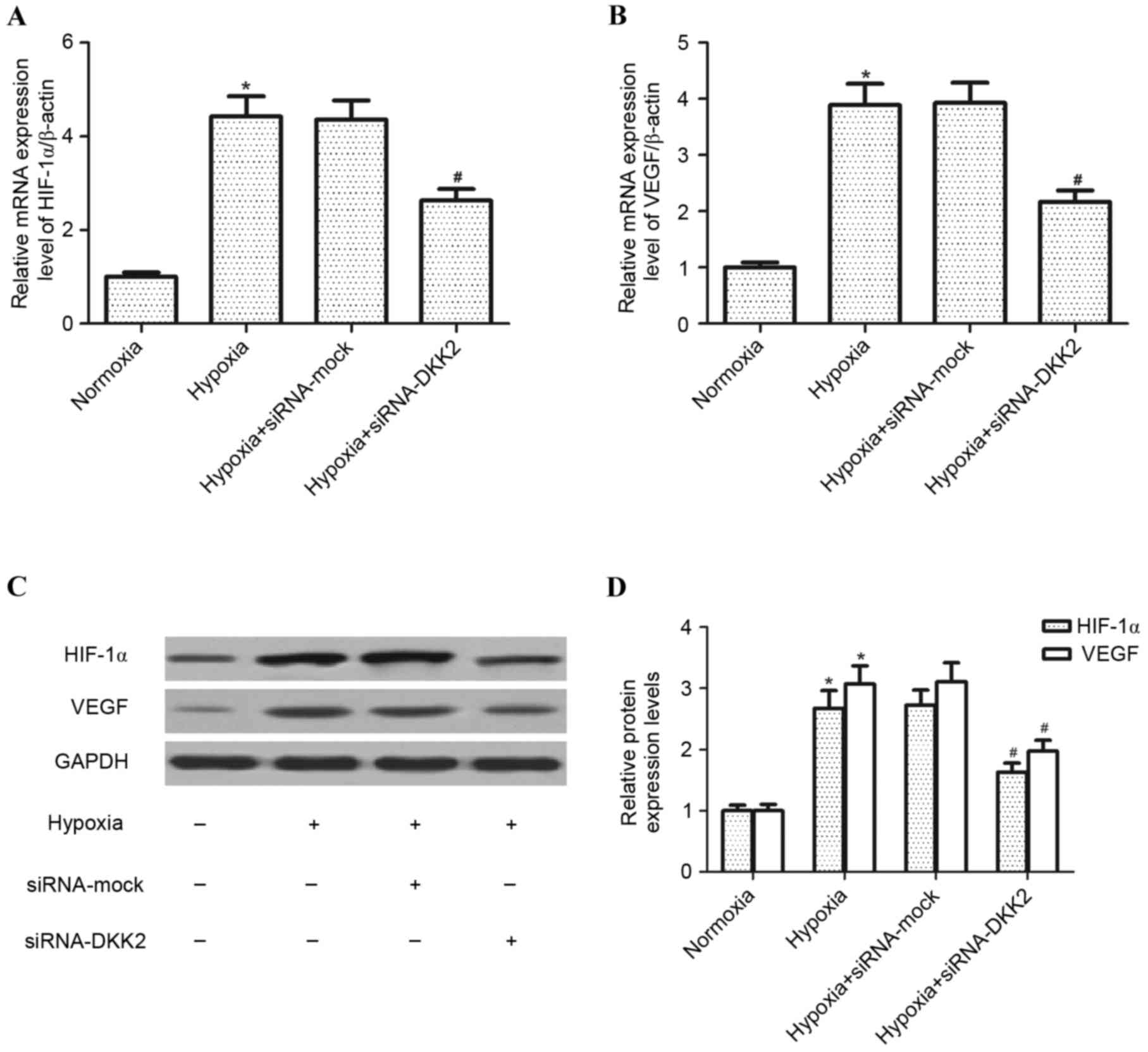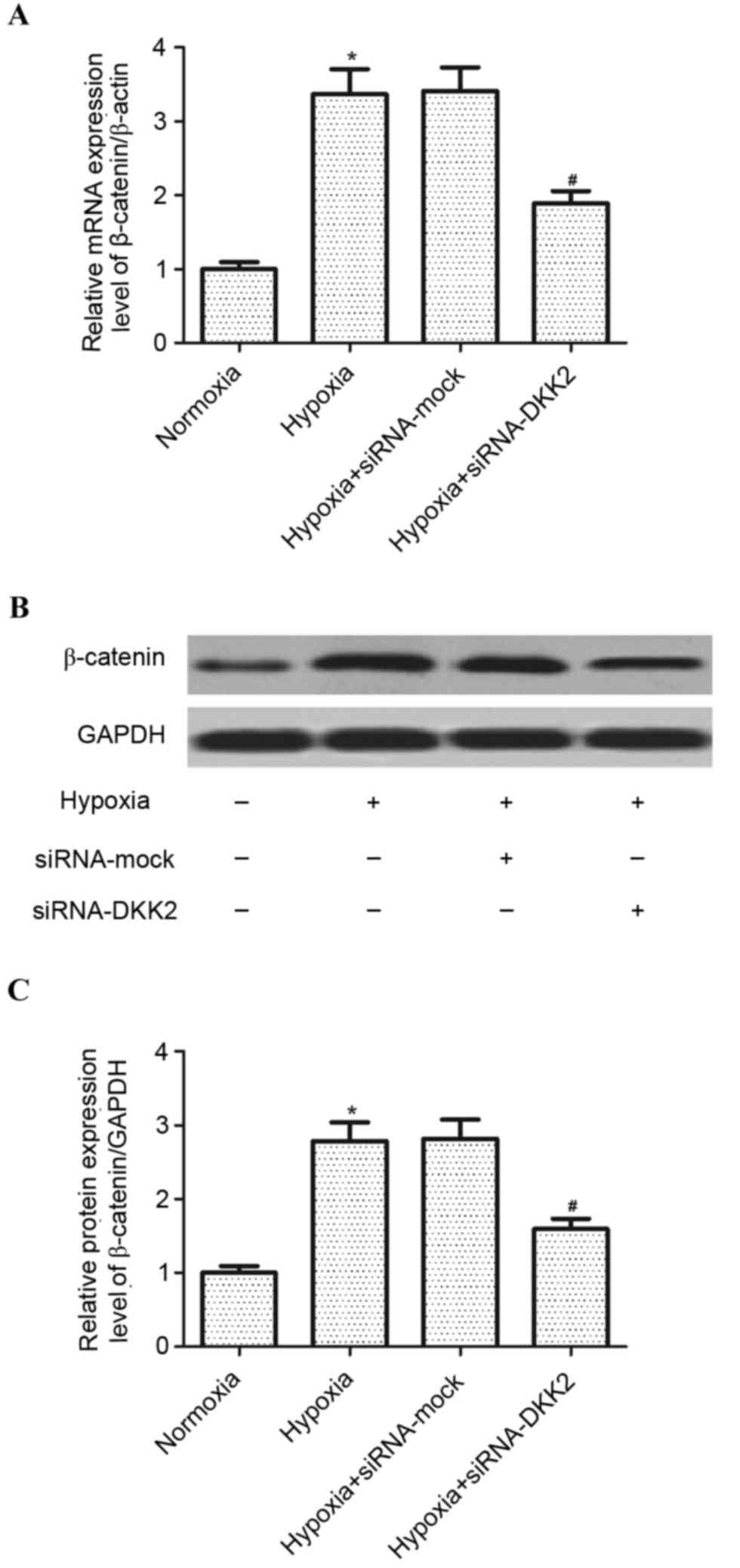Knockdown of dickkopf2 inhibits vascular endothelia growth factor expression through the Wnt/β-catenin signaling pathway in human retinal pigment epithelial cells under hypoxic conditions
- Authors:
- Published online on: February 28, 2018 https://doi.org/10.3892/etm.2018.5915
- Pages: 4056-4060
Abstract
Introduction
Choroidal neovascularization (CNV) is a serious complication of exudative age-related macular degeneration, which may result in significant loss of central vision (1). Retinal pigment epithelial (RPE) cells, located between the neurosensory retina and the vascular choroids, form the outer blood retinal barrier and have an important role in the pathogenesis of CNV (2). Hypoxia is also essential for the pathogenesis of CNV (3). Increasing research suggests that vascular endothelial growth factor (VEGF) upregulation produced by RPE cells under hypoxic conditions is a major angiogenic factor for CNV (4,5). Therefore, inhibiting hypoxia-induced VEGF expression may be a therapeutic approach for the treatment of CNV.
The Dickkopf (DKK) family of proteins modulates Wnt signaling. Members of the DKK protein family (DKK1, 2, 3 and 4) are secreted proteins with an N-terminal signal peptide and two conserved cysteine-rich domains separated by a linker region (6). DKK2 is a putative Wnt signaling inhibitor that is involved in tumor cell proliferation, migration and invasion (7–9). In addition, it has been postulated that DKK2 is involved in angiogenic processes. For example, one study demonstrated that DKK2 promoted angiogenesis in cultured human endothelial cells, and local injection of DKK2 protein significantly improved tissue repair, with enhanced neovascularization in animal models of both hind limb ischemia and myocardial infarction (10). Recently, a study by Park et al (11) demonstrated that DKK2 increased retinal vessel density and reduced the avascular area in an in vivo murine model of oxygen-induced retinopathy; however, the mechanism by which DKK2 contributes to this process is not clear. Therefore, the present study investigated the role of DKK2 in RPE cells under hypoxic conditions, and the molecular mechanisms were also explored.
Materials and methods
Cell culture and treatment
Human RPE cells were obtained from American Type Culture Collection (Manassas, VA, USA) and cultured in Dulbecco's modified Eagle Medium supplemented with F-12 nutrient mixture, 10% fetal bovine serum (Sigma-Aldrich; Merck KGaA, Darmstadt, Germany), 100 U/ml penicillin and 100 µg/ml streptomycin in a 5% CO2 incubator at 37°C. Cells were plated in 6-well culture dishes and used for experiments at 80–90% confluence. Cells were placed in fresh serum-free medium for 24 h prior to use. For culture under hypoxic conditions, RPE cells were incubated in a hypoxic chamber (Forma Scientific, San Bruno, CA, USA) to maintain the cells under low oxygen tension (5% CO2 with 1% O2, balanced with N2).
RNA extraction and reverse transcription-quantitative polymerase chain reaction (RT-qPCR)
For DNase treatment 2 units of DNase I (Invitrogen; Thermo Fisher Scientific, Inc., Waltham MA, USA) per µg of total RNA was added and incubated at 37°C for 30 min. Total RNA from RPE cells was isolated using TRIzol reagent (Invitrogen; Thermo Fisher Scientific, Inc.) according to the manufacturer's instructions. Subsequently, 2 µg of total RNA was transcribed to first-strand cDNA using TaqMan reverse transcription reagents (Applied Biosystems; Thermo Fisher Scientific, Inc.). PCR was performed using a CFX96 Real-Time PCR Detection System (Bio-Rad Laboratories, Inc., Hercules, CA, USA) and a SYBR PrimeScript RT-PCR kit (Takara Biotechnology Co., Ltd., Dalian, China), with a final reaction volume of 20 µl, containing 50 ng of total RNA, 10 µl 2xSYBR Green I reagent, 6.25 U Multi-Scribe reverse transcriptase, 10 U RNase inhibitor and 0.1 mM primers. The specific primers for DKK2 were sense 5′-AGTACCCGCTGCAATAATGG-3′ and antisense 5′-GAAATGACGAGCACAGCAAA-3′; and for β-actin, sense 5′-GATCATTGCTCCTCCTGAGC-3′ and antisense 5′-ACTCCTGCTTGCTGATCCAC-3′. PCR cycling conditions included a holding step at 94°C for 10 min, and 35 cycles of 94°C for 15 sec, 59°C for 30 sec and 70°C for 30 sec. β-actin was used as an internal control for normalizing gene expression. The data obtained were quantified using the 2−ΔΔCq method (12).
Western blot analysis
Proteins were extracted from RPE cells using radioimmunoprecipitation assay lysis buffer (Beyotime Institute of Biotechnology, Haimen, China), and the protein concentration was determined using a Bradford protein assay kit (Bio-Rad Laboratories, Inc.), according to the manufacturer's protocol. Equal amounts of protein sample (30 µg) were separated by 12% SDS-PAGE and transferred to a nitrocellulose membrane (Amersham; GE Healthcare Life Sciences, Little Chalfont, UK). Membranes were subsequently blocked at room temperature in Tris-buffered saline (TBS) containing 5% non-fat dry milk and incubated with the primary antibodies blocking solution overnight at 4°C. Primary antibodies included anti-DKK2 (1:3,000; PA5-18015; Invitrogen; Thermo Fisher Scientific, Inc.), anti-hypoxia inducible factor-1α (HIF-1α) (1:2,000; H6536; Sigma-Aldrich; Merck KGaA), anti-VEGF (1:2,500; sc-7269; Santa Cruz Biotechnology, Inc., Dallas, TX, USA), anti-β-catenin (1:3,000; sc-7963; Santa Cruz Biotechnology) and anti-glyceraldehyde 3-phosphate dehydrogenase (1:3,000; sc-47724; Santa Cruz Biotechnology, Inc.). Subsequent to washing with TBS-Tween 20 buffer, the membranes were incubated with bovine anti-mouse horseradish peroxidase-conjugated secondary antibody (1:3,000; sc-2380; Santa Cruz Biotechnology, Inc.) for 1 h at room temperature. The protein bands were visualized using enhanced chemiluminescence reagents (Gibco; Thermo Fisher Scientific, Inc.) according to the manufacturer's protocol. The absorbance values of the target proteins were obtained using Gel-Pro Analyzer v.4.0 software (Media Cybernetics, Inc., Rockville, MD, USA).
Transfection of small interfering (si) RNA
The small interfering RNA expression vector that expresses DKK2 was purchased from Shanghai GenePharma Co., Ltd. (Shanghai, China). For in vitro transfection, RPE cells were seeded in each well of 96-well microplates, grown for 24 h to reach 60% confluence and subsequently transfected with siRNA-DKK2 or scramble control using Lipofectamine 2000 (Invitrogen; Thermo Fisher Scientific, Inc.), according to the manufacturer's instructions.
Statistical analysis
Statistical analysis was performed using SPSS v.16.0 software (SPSS, Inc., Chicago, IL, USA). All experiments were repeated three times. Results were presented as the mean ± standard deviation. Statistical analysis was performed using one-way analysis of variance. P<0.05 was considered to indicate a statistically significant difference.
Results
Hypoxia induces DKK2 expression in RPE cells
Hypoxia is the principal physiological stimulus that induces angiogenesis to ensure sufficient levels of oxygen are available to developing cells (13). Therefore, the expression of DKK2 at both the mRNA and protein expression level in RPE cells under normoxic and hypoxic conditions was investigated. As exhibited in Fig. 1A, the expression level of DKK2 mRNA was significantly increased (P<0.05) by hypoxia treatment, as compared with the normoxia group. In addition, hypoxia treatment significantly increased (P<0.05) the protein expression levels of DDK2 in RPE cells (Fig. 1B) compared with the normoxia group.
RNA interference suppresses DKK2 mRNA and protein expression
The knockdown of DKK2 was induced by a lentivirus-mediated RNA interference vector in RPE cells and the transfection efficiency was evaluated. As exhibited in Fig. 2, following transfection, the expression of DKK2 was significantly decreased (P<0.05) at both the RNA and protein expression levels in RPE cells under hypoxic conditions compared with controls. The siRNA-DKK2 reduced DKK2 mRNA levels to 36.7±2.4% of the siRNA-mock and decreased DKK2 protein expression levels to 27.2±2.1% of the siRNA-mock.
Knockdown of DKK2 inhibits hypoxia-induced HIF-1α and VEGF expression in RPE cells
The effect of DKK2 on the expression of HIF-1α and VEGF in hypoxia-stimulated RPE cells was investigated. Exposure to hypoxia for 24 h resulted in a significant increase in HIF-1α (P<0.05) and VEGF (P<0.05) mRNA expression levels in RPE cells compared with the control group; however, knockdown of DKK2 significantly inhibited (P<0.05) this hypoxia-induced increase in HIF-1α and VEGF mRNA (Fig. 3A and B, respectively). Furthermore, DKK2 silencing significantly inhibited the hypoxia-induced expression levels of HIF-1α (P<0.05) and VEGF (P<0.05) protein in RPE cells compared with the siRNA-mock control (Fig. 3B and C).
Knockdown of DKK2 inhibits hypoxia-induced Wnt/β-catenin activation in RPE cells
In order to explore the signaling pathway involved in siRNA-DKK2-induced inhibition of VEGF expression in hypoxia-stimulated RPE cells, the effect of DKK2 on Wnt/β-catenin activation was investigated. As exhibited in Fig. 4, hypoxia treatment significantly increased (P<0.05) the expression of β-catenin, at both the mRNA and protein expression level, compared with the mock-transfected control group; however, knockdown of DKK2 significantly inhibited (P<0.05) the mRNA and protein expression of β-catenin induced by hypoxia in RPE cells.
Discussion
CNV is the common pathological cause of irreversible visual impairment encountered in a series of chorioretinal diseases (1); however, the pathogenesis of its development is complicated and poorly understood. In the present study, it was demonstrated that hypoxic conditions induced the expression of DKK2 in RPE cells and that knockdown of DKK2 inhibits the hypoxia-induced expression of HIF-1α and VEGF in RPE cells. Furthermore, knockdown of DKK2 significantly inhibited the hypoxia-induced expression of β-catenin in RPE cells.
Hypoxia is a common environmental stress that influences signaling pathways and cell function and, through the initiation of intracellular signaling pathways, induces the activation of the transcription factor, HIF-1α (14,15). It has been reported that hypoxia stimulates the expression of HIF-1, HIF-2, and DKK2 in human osteoarthritis osteoblasts (16). Similarly, in the present study, it was demonstrated that hypoxia induces the expression of DKK2 in RPE cells. These results suggest that DKK2 may have a critical role in the pathogenesis of CNV.
VEGF is one of the most well-characterized angiogenic factors in CNV and is regulated by HIF-1 (17). Previous studies have demonstrated that hypoxia induces VEGF production in several cell types (18–20). For example, a study by Park et al (21) reported that hypoxia induced the transcriptional activity of HIF-1α, leading to an increase in the expression of its downstream target, VEGF, in human vascular endothelial cells. Hypoxia has been demonstrated to increase the expression levels of VEGF via upregulation of HIF-1α irrespective of p53 gene status in ovarian cancer cells (22). Consistent with these reports, in the present study, it was observed that exposure to hypoxia for 24 h resulted in a significant increase in HIF-1α and VEGF expression levels in RPE cells; however, knockdown of DKK2 was able to inhibit the hypoxia-induced HIF-1α and VEGF expression levels in RPE cells. These results suggest that DKK2 silencing is able to partly block the hypoxia-induced upregulation of VEGF in RPE cells by downregulating the expression levels of HIF-1α.
Extensive data indicates that the Wnt/β-catenin signaling pathway has a critical role in the regulation of angiogenesis (23–25). A key regulator of this pathway is intracellular β-catenin, which is a transcription coactivator (26). It has been reported that the aberrant upregulation of the Wnt/β-catenin signaling pathway at multiple levels, including Wnt ligands, low-density lipoprotein receptor-related protein 6 and β-catenin, has been observed in laser-induced CNV models (27). In addition, nuclear β-catenin regulates gene transcription by interacting with Wnt target and activator genes (T-cell factor-1/lymphoid enhancer binding factor-1) and knockdown of HIF-1α inhibits the hypoxia-increased accumulation of β-catenin in the nucleus (28). Therefore, attenuation of the Wnt/β-catenin pathway may be a potential strategy for treating CNV. Monoclonal antibody (Mab)2F1, a novel inhibitor of the canonical Wnt pathway, has been demonstrated to suppress the hypoxia-induced activation of Wnt signaling in cultured RPE cells, thereby ameliorating CNV (27). Similar to the role of Mab2F1 in RPE cells under hypoxic conditions, in the present study, it was demonstrated that knockdown of DKK2 inhibited the hypoxia-induced expression of β-catenin in RPE cells. These results suggest that DKK2 silencing may mediate its anti-angiogenesis action by inhibiting the Wnt/β-catenin signaling pathway, in turn suppressing VEGF expression in human RPE cells.
In conclusion, the results of the present study demonstrated that DKK2 is a vascular regulator involved in CNV angiogenesis. Knockdown of DKK2 suppressed hypoxia-induced VEGF expression via the inhibition of the Wnt/β-catenin signaling pathway in RPE cells. These findings may facilitate further understanding of the mechanisms that underlie CNV angiogenesis and provide an innovative treatment strategy for ocular angiogenesis.
References
|
Jager RD, Mieler WF and Miller JW: Age-related macular degeneration. N Engl J Med. 358:2606–2617. 2008. View Article : Google Scholar : PubMed/NCBI | |
|
Schwesinger C, Yee C, Rohan RM, Joussen AM, Fernandez A, Meyer TN, Poulaki V, Ma JJ, Redmond TM, Liu S, et al: Intrachoroidal neovascularization in transgenic mice overexpressing vascular endothelial growth factor in the retinal pigment epithelium. Am J Pathol. 158:1161–1172. 2001. View Article : Google Scholar : PubMed/NCBI | |
|
Sheridan CM, Pate S, Hiscott P, Wong D, Pattwell DM and Kent D: Expression of hypoxia-inducible factor-1alpha and-2alpha in human choroidal neovascular membranes. Graefes Arch Clin Exp Ophthalmol. 247:1361–1367. 2009. View Article : Google Scholar : PubMed/NCBI | |
|
Dong X, Wang YS, Dou GR, Hou HY, Shi YY, Zhang R, Ma K, Wu L, Yao LB, Cai Y and Zhang J: Influence of Dll4 via HIF-1a-VEGF signaling on the angiogenesis of choroidal neovascularization under hypoxic conditions. PLoS One. 6:e184812011. View Article : Google Scholar : PubMed/NCBI | |
|
Mousa SA, Lorelli W and Campochiaro PA: Role of hypoxia and extracellular matrix-integrin binding in the modulation of angiogenic growth factors secretion by retinal pigmented epithelial cells. J Cell Biochem. 74:135–143. 1999. View Article : Google Scholar : PubMed/NCBI | |
|
Krupnik VE, Sharp JD, Jiang C, Robison K, Chickering TW, Amaravadi L, Brown DE, Guyot D, Mays G, Leiby K, et al: Functional and structural diversity of the human Dickkopf gene family. Gene. 238:301–313. 1999. View Article : Google Scholar : PubMed/NCBI | |
|
Kawakita A, Yanamoto S, Yamada S-i, Naruse T, Takahashi H, Kawasaki G and Umeda M: MicroRNA-21 promotes oral cancer invasion via the Wnt/β-catenin pathway by targeting DKK2. Pathol Oncol Res. 20:253–261. 2014. View Article : Google Scholar : PubMed/NCBI | |
|
Hirata H, Hinoda Y, Nakajima K, Kawamoto K, Kikuno N, Kawakami K, Yamamura S, Ueno K, Majid S, Saini S, et al: Wnt antagonist gene DKK2 is epigenetically silenced and inhibits renal cancer progression through apoptotic and cell cycle pathways. Clin Cancer Res. 15:5678–5687. 2009. View Article : Google Scholar : PubMed/NCBI | |
|
Zhu J, Zhang S, Gu L and Di W: Epigenetic silencing of DKK2 and Wnt signal pathway components in human ovarian carcinoma. Carcinogenesis. 33:2334–2343. 2012. View Article : Google Scholar : PubMed/NCBI | |
|
Min JK, Park H, Choi HJ, Kim Y, Pyun BJ, Agrawal V, Song BW, Jeon J, Maeng YS, Rho SS, et al: The WNT antagonist Dickkopf2 promotes angiogenesis in rodent and human endothelial cells. J Clin Invest. 121:1882–1893. 2011. View Article : Google Scholar : PubMed/NCBI | |
|
Park H, Jung HY, Choi HJ, Kim DY, Yoo JY, Yun CO, Min JK, Kim YM and Kwon YG: Distinct roles of DKK1 and DKK2 in tumor angiogenesis. Angiogenesis. 17:221–234. 2014. View Article : Google Scholar : PubMed/NCBI | |
|
Livak KJ and Schmittgen TD: Analysis of relative gene expression data using real-tie quantitative PCR and the 2(-Delta Delta C(T)) Method. Methods. 25:402–408. 2001. View Article : Google Scholar : PubMed/NCBI | |
|
Pugh CW and Ratcliffe PJ: Regulation of angiogenesis by hypoxia: Role of the HIF system. Nat Med. 9:677–684. 2003. View Article : Google Scholar : PubMed/NCBI | |
|
Semenza GL: Hydroxylation of HIF-1: Oxygen sensing at the molecular level. Physiology (Bethesda). 19:176–182. 2004.PubMed/NCBI | |
|
Semenza GL: HIF-1: Mediator of physiological and pathophysiological responses to hypoxia. J Appl Physiol (1985). 88:1474–1480. 2000. View Article : Google Scholar : PubMed/NCBI | |
|
Bouvard B, Abed E, Yéléhé-Okouma M, Bianchi A, Mainard D, Netter P, Jouzeau JY, Lajeunesse D and Reboul P: Hypoxia and vitamin D differently contribute to leptin and dickkopf-related protein 2 production in human osteoarthritic subchondral bone osteoblasts. Arthritis Res Ther. 16:4592014. View Article : Google Scholar : PubMed/NCBI | |
|
Yang XM, Wang YS, Zhang J, Li Y, Xu JF, Zhu J, Zhao W, Chu DK and Wiedemann P: Role of PI3K/Akt and MEK/ERK in mediating hypoxia-induced expression of HIF-1alpha and VEGF in laser-induced rat choroidal neovascularization. Invest Ophthalmol Vis Sci. 50:1873–1879. 2009. View Article : Google Scholar : PubMed/NCBI | |
|
Hata Y, Nakagawa K and Sueishi K, Ishibashi T, Inomata H, Ueno H and Sueishi K: Hypoxia-induced expression of vascular endothelial growth factor by retinal glial cells promotes in vitro angiogenesis. Virchows Arch. 426:479–486. 1995. View Article : Google Scholar : PubMed/NCBI | |
|
Liu Y, Cox SR, Morita T and Kourembanas S: Hypoxia regulates vascular endothelial growth factor gene expression in endothelial cells identification of a 5′ enhancer. Circ Res. 77:638–643. 1995. View Article : Google Scholar : PubMed/NCBI | |
|
Akeno N, Czyzyk-Krzeska MF, Gross TS and Clemens TL: Hypoxia induces vascular endothelial growth factor gene transcription in human osteoblast-like cells through the hypoxia-inducible factor-2α. Endocrinology. 142:959–962. 2001. View Article : Google Scholar : PubMed/NCBI | |
|
Park JJ, Hwang SJ, Park JH and Lee HJ: Chlorogenic acid inhibits hypoxia-induced angiogenesis via down-regulation of the HIF-1α/AKT pathway. Cell Oncol (Dordr). 38:111–118. 2015. View Article : Google Scholar : PubMed/NCBI | |
|
Horiuchi A, Imai T, Shimizu M, Oka K, Wang C, Nikaido T and Konishi I: Hypoxia-induced changes in the expression of VEGF, HIF-1 alpha and cell cycle-related molecules in ovarian cancer cells. Anticancer Res. 22:2697–2702. 2001. | |
|
Zhou T, Hu Y, Chen Y, Zhou KK, Zhang B, Gao G and Ma JX: The pathogenic role of the canonical Wnt pathway in age-related macular degeneration. Invest Ophthalmol Vis Sci. 51:4371–4379. 2010. View Article : Google Scholar : PubMed/NCBI | |
|
Easwaran V, Lee SH, Inge L, Guo L, Goldbeck C, Garrett E, Wiesmann M, Garcia PD, Fuller JH, Chan V, et al: beta-Catenin regulates vascular endothelial growth factor expression in colon cancer. Cancer Res. 63:3145–3153. 2003.PubMed/NCBI | |
|
Daneman R, Agalliu D, Zhou L, Kuhnert F, Kuo CJ and Barres BA: Wnt/beta-catenin signaling is required for CNS, but not non-CNS, angiogenesis. Proc Natl Acad Sci USA. 106:641–646. 2009. View Article : Google Scholar : PubMed/NCBI | |
|
Clevers H and Nusse R: Wnt/β-catenin signaling and disease. Cell. 149:1192–1205. 2012. View Article : Google Scholar : PubMed/NCBI | |
|
Hu Y, Chen Y, Lin M, Lee K, Mott RA and Ma JX: Pathogenic role of the Wnt signaling pathway activation in laser-induced choroidal neovascularization. Invest Ophthalmol Vis Sci. 54:141–154. 2013. View Article : Google Scholar : PubMed/NCBI | |
|
Mitani T, Harada N, Nakano Y, Inui H and Yamaji R: Coordinated action of hypoxia-inducible factor-1α and β-catenin in androgen receptor signaling. J Biol Chem. 287:33594–33606. 2012. View Article : Google Scholar : PubMed/NCBI |













